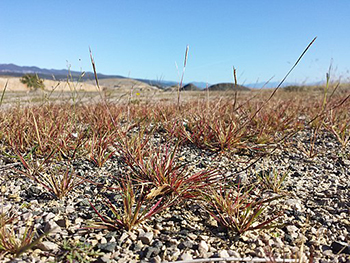
EPPO Alert List – Sporobolus neglectus and Sporobolus vaginiflorus (Poaceae)
Why
Sporobolus neglectus and S. vaginiflorus (Poaceae) are North American grass species which occur locally in the EPPO region. In some areas where the plants spread along transportation routes, they have shown invasive tendencies. The EPPO Panel on Invasive Alien Plants are seeking further information on the occurrence and behaviour of S. neglectus and S. vaginiflorus in the EPPO region.
Geographical distribution
S. neglectus
EPPO region: Austria, Croatia, France, Hungary, Italy, Slovenia, Switzerland.
North America: Canada (Alberta, Manitoba, New Brunswick, Ontario, Québec, Saskatchewan,), USA (Alabama, Arizona, Arkansas, California, Colorado, Connecticut, District of Columbia, Illinois, Indiana, Iowa, Kansas, Kentucky, Louisiana, Maine, Maryland, Massachusetts, Michigan, Minnesota, Missouri, Montana, Nebraska, New Hampshire, New Jersey, New Mexico, New York, North Dakota, Ohio, Oklahoma, Pennsylvania, South Dakota, Tennessee, Texas, Vermont, Virginia, Washington, West Virginia, Wisconsin, Wyoming).
S. vaginiflorus
EPPO region: Austria, France, Germany, Hungary, Italy, Serbia, Slovenia, Switzerland.
North America: Canada (British Columbia, New Brunswick, Nova Scotia, Ontario, Prince Edward Island, Québec), USA (Alabama, Arizona, Arkansas, California, Connecticut, Delaware, District of Columbia, Florida, Georgia, Illinois, Indiana, Iowa, Kansas, Kentucky, Louisiana, Maine, Maryland, Massachusetts, Michigan, Minnesota, Mississippi, Missouri, Nebraska, New Hampshire, New Jersey, New Mexico, New York, North Carolina, North Dakota, Ohio, Oklahoma, Pennsylvania, Rhode Island, South Carolina, South Dakota, Tennessee, Texas, Vermont, Virginia, West Virginia, Wisconsin).
Morphology
S. neglectus
Annual plant tufted, delicate, slender. Culms 10-45 cm, wiry, erect to decumbent. Sheaths inflated, mostly glabrous but the apices with small tufts of hairs. Blades 1-12 cm long, 0.6-2 mm wide, flat to loosely involute. Panicles terminal and axillary. Glumes subequal, shorter than the florets, lanceolate to ovate, membranous to chartaceous, glabrous. Fruits 1.2-1.8 mm, obovoid, laterally flattened, light brownish or orangish-brown, translucent, finely striate.
S. vaginiflorus
Annual plant tufted, delicate. Culms 15-60(70) cm, erect to decumbent, wiry. Sheaths often inflated, sometimes with sparse hairs basally. Blades 2-12(25) cm long, 0.6-2 mm wide, flat to loosely involute. Panicles terminal and axillary, 1-5 cm long, 0.2-0.5 cm wide, contracted, cylindrical. Glumes subequal, linear-lanceolate to lanceolate-triangular or ovate, membranous to chartaceous, glabrous. Fruits (1.1)1.8-2.7 mm, obovoid, laterally flattened, light brownish, translucent.
Biology and Ecology
Sporobolus neglectus and S. vaginiflorus are perennial species that reproduce by seed and vegetatively from fragments of rhizome which can take root and form new infestations.
Habitats
Sporobolus neglectus and S. vaginiflorus prefer open, often disturbed habitats with sandy to gravelly soils and thrive in various plant communities. In the EPPO region, both species have been observed to spread along transportation routes.
Pathways for movement
Sporobolus neglectus and S. vaginiflorus probably originally entered the EPPO region as contaminants of machinery and equipment by American military forces in the 1940s. Entry via contamination of seed mixtures from the USA has also been suggested.
Impacts
Sporobolus neglectus and S. vaginiflorus can have a negative impact on the species richness and abundance of native vegetation. Both species can form dense monospecific stands in the late summer and autumn along roadsides and these populations may spread into natural grasslands. Both species can produce an abundance of small seeds which can form a persistent seed bank. This facilitates establishment of the species in new areas and complicates the control of the species as the seed bank will need to be exhausted to achieve successful control.
Control
There is no specific information on control. Any management method should exhaust the persistent seedbank.
Sources
Englmaier P, Wilhalm T (2018) Alien grasses (Poaceae) in the flora of the Eastern Alps: Contribution to an excursion flora of Austria and the Eastern Alps. Neilreichia 9, 177–245.
Jogan N (2017) Spread of Sporobolus neglectus and S. vaginiflorus (Poaceae) in Slovenia and neighbouring countries. Botanical Serbica 41, 249-256.
Király G, Hohla M (2015) New stage of the invasion: Sporobolus vaginiflorus (Poaceae) reached Hungary. Studia botanica hungarica 46, 149–155.

